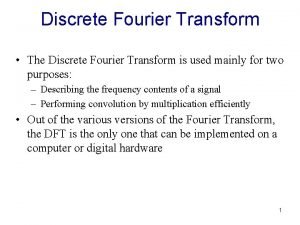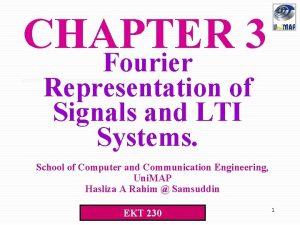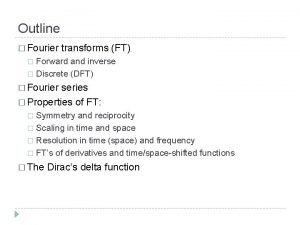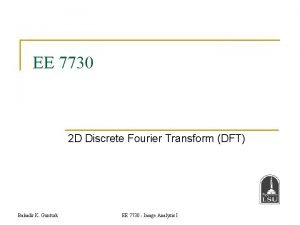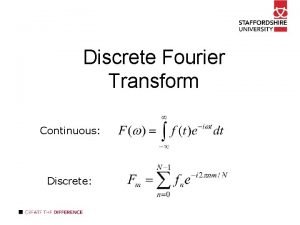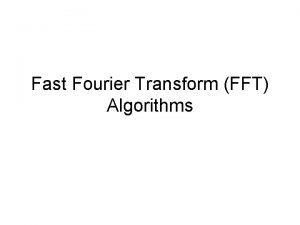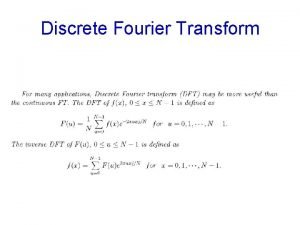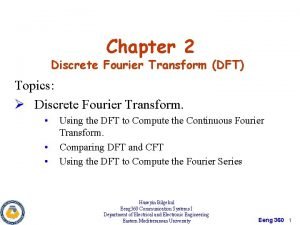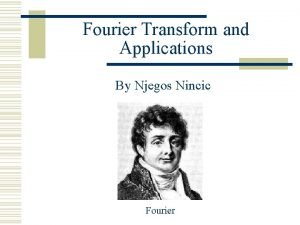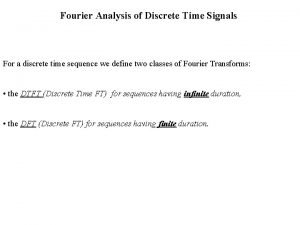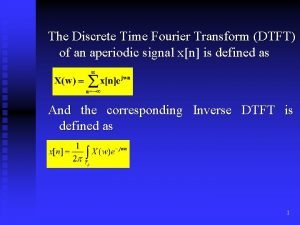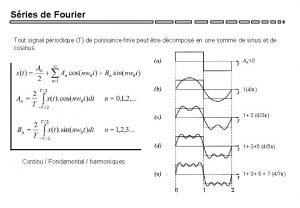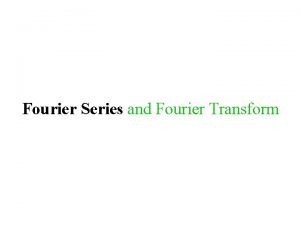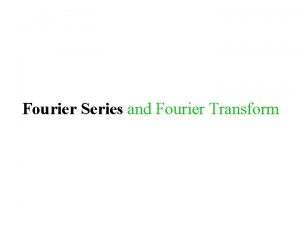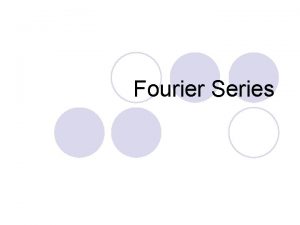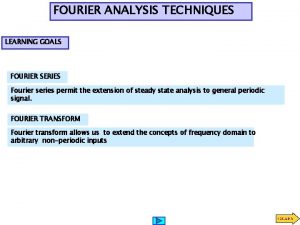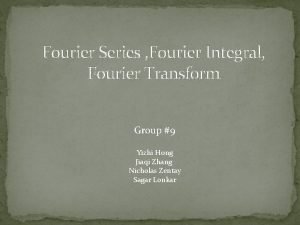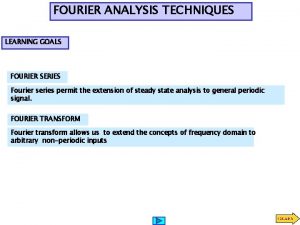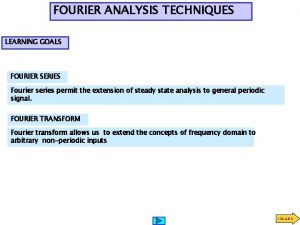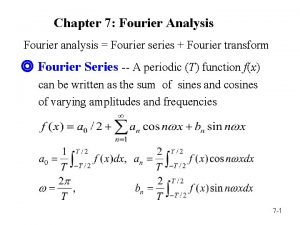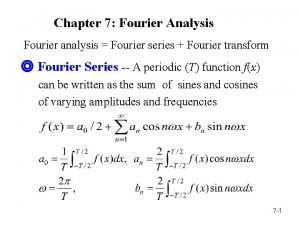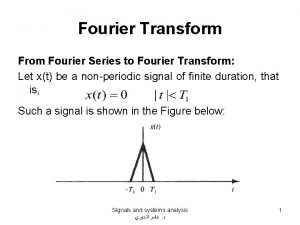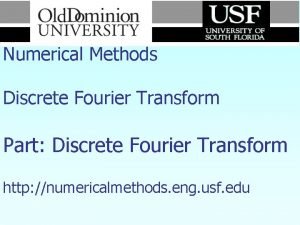The Discrete Fourier Series Quote of the Day













![Relation between Finite-length and Periodic Signals • Consider finite length signal x[n] spanning from Relation between Finite-length and Periodic Signals • Consider finite length signal x[n] spanning from](https://slidetodoc.com/presentation_image/06162f18ab245db1687426af32d91682/image-14.jpg)

- Slides: 15

The Discrete Fourier Series Quote of the Day Whoever despises the high wisdom of mathematics nourishes himself on delusion. Leonardo da Vinci Copyright (C) 2005 Güner Arslan 351 M Digital Signal Processing Content and Figures are from Discrete-Time Signal Processing, 2 e by Oppenheim, Shafer, and Buck, © 1999 -2000 Prentice Hall Inc.

Discrete Fourier Series • Given a periodic sequence with period N so that • The Fourier series representation can be written as • The Fourier series representation of continuous-time periodic signals require infinite many complex exponentials • Not that for discrete-time periodic signals we have • Due to the periodicity of the complex exponential we only need N exponentials for discrete time Fourier series Copyright (C) 2005 Güner Arslan 351 M Digital Signal Processing 2

Discrete Fourier Series Pair • A periodic sequence in terms of Fourier series coefficients • The Fourier series coefficients can be obtained via • For convenience we sometimes use • Analysis equation • Synthesis equation Copyright (C) 2005 Güner Arslan 351 M Digital Signal Processing 3

Example 1 • DFS of a periodic impulse train • Since the period of the signal is N • We can represent the signal with the DFS coefficients as Copyright (C) 2005 Güner Arslan 351 M Digital Signal Processing 4

Example 2 • DFS of an periodic rectangular pulse train • The DFS coefficients Copyright (C) 2005 Güner Arslan 351 M Digital Signal Processing 5

Properties of DFS • Linearity • Shift of a Sequence • Duality Copyright (C) 2005 Güner Arslan 351 M Digital Signal Processing 6

Symmetry Properties Copyright (C) 2005 Güner Arslan 351 M Digital Signal Processing 7

Symmetry Properties Cont’d Copyright (C) 2005 Güner Arslan 351 M Digital Signal Processing 8

Periodic Convolution • Take two periodic sequences • Let’s form the product • The periodic sequence with given DFS can be written as • Periodic convolution is commutative Copyright (C) 2005 Güner Arslan 351 M Digital Signal Processing 9

Periodic Convolution Cont’d • Substitute periodic convolution into the DFS equation • Interchange summations • The inner sum is the DFS of shifted sequence • Substituting Copyright (C) 2005 Güner Arslan 351 M Digital Signal Processing 10

Graphical Periodic Convolution Copyright (C) 2005 Güner Arslan 351 M Digital Signal Processing 11

The Fourier Transform of Periodic Signals • Periodic sequences are not absolute or square summable – Hence they don’t have a Fourier Transform • We can represent them as sums of complex exponentials: DFS • We can combine DFS and Fourier transform • Fourier transform of periodic sequences – Periodic impulse train with values proportional to DFS coefficients – This is periodic with 2 since DFS is periodic • The inverse transform can be written as Copyright (C) 2005 Güner Arslan 351 M Digital Signal Processing 12

Example • Consider the periodic impulse train • The DFS was calculated previously to be • Therefore the Fourier transform is Copyright (C) 2005 Güner Arslan 351 M Digital Signal Processing 13
![Relation between Finitelength and Periodic Signals Consider finite length signal xn spanning from Relation between Finite-length and Periodic Signals • Consider finite length signal x[n] spanning from](https://slidetodoc.com/presentation_image/06162f18ab245db1687426af32d91682/image-14.jpg)
Relation between Finite-length and Periodic Signals • Consider finite length signal x[n] spanning from 0 to N-1 • Convolve with periodic impulse train • The Fourier transform of the periodic sequence is • This implies that • DFS coefficients of a periodic signal can be thought as equally spaced samples of the Fourier transform of one period Copyright (C) 2005 Güner Arslan 351 M Digital Signal Processing 14

Example • Consider the following sequence • The Fourier transform • The DFS coefficients Copyright (C) 2005 Güner Arslan 351 M Digital Signal Processing 15
 Day 1 day 2 day 3 day 4
Day 1 day 2 day 3 day 4 Discrete time fourier series
Discrete time fourier series What is discrete fourier transform
What is discrete fourier transform Magnitude and phase response
Magnitude and phase response Day 1 day 2 day 817
Day 1 day 2 day 817 Inverse fourier transform of delta function
Inverse fourier transform of delta function Ee
Ee Discrete fourier transform
Discrete fourier transform Fft decimation in frequency
Fft decimation in frequency Discrete fourier transform
Discrete fourier transform Discrete fourier transform
Discrete fourier transform Application of discrete fourier transform
Application of discrete fourier transform Fourier analysis of discrete time signals
Fourier analysis of discrete time signals Discrete time fourier transform
Discrete time fourier transform Image processing and analysis birchfield pdf
Image processing and analysis birchfield pdf Spectre signal echantillonné
Spectre signal echantillonné


